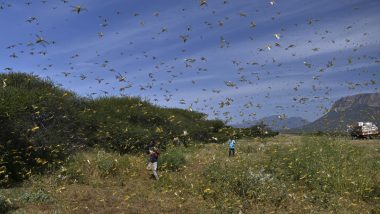New Delhi, May 26: As the country was yet to emerge out of novel coronavirus crisis, a swarm of millions of locusts have descended over several Indian states, threatening standing crops and vegetations. Also known as Tiddi dal, locusts are known to destroy everything in their path, posing threat to the food supply and livelihood of millions of people. Locust Attack: What Happens When This Pest Invades Farms? Know All About The Worst-Ever 'Tiddi Dal' Attack as Fear Grips Farmers in Rajasthan, Gujarat, Punjab and Other Indian States.
The Food and Agriculture Organisation (FAO) of the United Nations (UD) in February had issued a warning about twin invasion of desert locusts coming to India starting in May 2020. The huge swarms of locusts have already entered Rajasthan, Madhya Pradesh, Uttar Pradesh, Punjab and Haryana. They are now posing a threat to the other states. Locust Attack in Rajasthan's Jaipur: Insects Destroy Crops Spread Over 5,00,000 Hectares.
Locust Attack Hits Several States, Watch Video:
What are Locusts?
Locusts are a certain species of short-horned grasshoppers, which are similar to crickets. Locusts are usually not harmful, but in certain conditions they become more abundant and change their behaviour, becoming "gregarious". Tiddi dal are also capable of forming ‘swarms’ and ‘hopper bands’.
Where Did They Originate?
According to the FAO, this swarm originated in the Horn of Africa, where heavy rains and cyclones triggered a breeding boom. Locust Swarm Attacks North India: Scary Pics and Videos of 'Tiddi Dal' From Rajasthan, Madhya Pradesh and Uttar Pradesh Worry Farmers.
Here's Everything You Need To Know About Locusts Attack in India and Other Nations:
- Desert locusts feed on any kind of green vegetation. According to the FAO, a locust population spread over an area of one square kilometre can ravage crop meant for 35,000 people in a day.
- Last year, Pakistan suffered one of its worst locusts attack devouring cotton, maise and wheat, among other crops. They invaded Pakistan in June 2019 and were initially expected to subside by November. However, favourable weather conditions continued locusts breeding.
- In May 2020, the locusts made their way into India via Pakistan and attacked crops and vegetations in Rajasthan, Gujarat, Punjab, Haryana, Madhya Pradesh and Uttar Pradesh.
- Sensing the scale of the problem, the Locust Warning Organisation in Rajasthan has order sprinkling of chemicals by drones to kill locust.
- The tiddi dal are now entering other states posing threat to food supply and livelihood.
- Their life span is between three to five months. They can start laying eggs when they are 60-70 days old.
- Locusts can fly as far as 150 km a day, making them difficult to control. However, there are some chemicals and nature-based biopesticides for controlling outbreaks.
- Recently, the World Bank approved $500 million in grants and low interest loans to help nations in Africa and the Middle East in the fight against swarms of desert locusts.
- The most affected countries are Ethiopia, Kenya, Uganda and Djibouti.
- In Kenya, the locusts are eating in one day the amount of food consumed by Kenyans in two days.
Locusts attack could pose a grave challenge in 2020. Till now, they have destroyed thousands of acres of crops at a time when the global economy is struggling to recover from COVID-19 crisis.
(The above story first appeared on LatestLY on May 26, 2020 06:18 PM IST. For more news and updates on politics, world, sports, entertainment and lifestyle, log on to our website latestly.com).













 Quickly
Quickly













